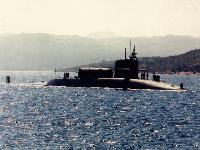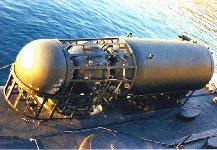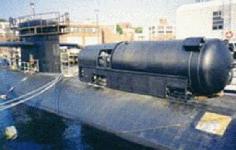



Dry Deck Shelter
Any US submarine can be employed to carry SEALs, however, the Navy has several submarines that have been specially modified to carry swimmers and their equipment more effectively, including the installation of chambers called Dry Deck Shelters (DDSs) to house Swimmer Delivery Vehicles (SDVs). These submarines retain their full suite of weapons and sensors for operations as attack submarines. But they have special fittings, modifications to their air systems and other features to enable them to carry Dry Deck Shelters. The DDS can be used to transport and launch an SDV or to "lock out" combat swimmers. A DDS can be installed in about 12 hours and is air-transportable, further increasing special operations flexibility.
Overall, the DDS is 9 feet wide, 9 feet high, 38 feet long, and displaces 30 tons. It consists of three interconnected compartments made of HY-80 steel within a fiberglass fairing, each capable of independent pressurization to a depth of at least 130 feet. The forward-most compartment, a sphere, is the hyperbaric chamber which is used for treatment of injured divers. In the middle compartment, or transfer trunk, operators enter and exit the submarine and/or either of the other compartments. The third compartment, the hangar, is a cylinder with elliptical ends which houses either the SDV or up to 20 SOF personnel with CRRCs.
The DDS, fitted aft of the submarine's sail structure, is connected to the submarine's after hatch to permit free passage between the submarine and the DDS while the submarine is underwater and approaching the objective area. Then, with the submarine still submerged, the SEALs can exit the DDS and ascend to the surface, bringing with them equipment and rubber rafts, or they can mount an SDV and travel underwater several miles to their objective area.
The number of SEALs carried in a submarine for a special operation varies with the mission, duration, target and other factors. One or more SEAL platoons of two officers and 14 enlisted men are normally embarked, plus additional SEALs to help with mission planning in the submarine and to handle equipment. Former SSBNs employed to operate with SEALs have special berthing spaces for about 50 SEALs.
The concept of a detachable Dry Deck Shelter with the ability to house, deploy, and retrieve SDVs, was born in the late 1970s. The Electric Boat Division of General Dynamics Corporation completed DDS-01S in 1982. [Note: The number indicates its order of construction, and the �S� indicates that its outer hangar door opens to the starboard side.] Newport News Shipbuilding completed the construction of DDS-02P, -03P, -04S, -05S, and -06P between 1987 and 1991.
Two shelters can be installed aboard Benjamin Franklin Class former ballistic missile submarines; other submarine classes are single-shelter ships.
The dual DDS carriers provide a much greater SOF platform than the single DDS carriers. The dual DDS submarine provides more room on the submarine, allows for more flexible mission planning, and has inherent redundancy.
The dual DDS carriers have more mission flexibility than the single carriers. One DDS can be loaded with an SDV and the other DDS loaded with Combat Rubber Raiding Craft. This allows the flexibility to conduct SDV operations, Mass Swimmer Lock-outs, or both. An empty DDS also allows the ability to recover an SDV launched from shore or another submarine (USS JOHN MARSHALL demonstrated the capability to recover and launch another country�s SDV during a multi-lateral exercise in the Mediterranean). The ability of the SEALs to maintain physical conditioning allows the submarine/SEAL team to stay on station longer. The longer the submarine can stay on the station the longer national leadership has to attempt a diplomatic resolution before the decision must be made to conduct the mission or depart the area.
The dual DDS submarine has inherent redundancy compared to the single DDS. The two DDSs operate and interface with the submarine systems totally independently. Therefor, a material casualty on one system would not result in aborting the mission. The mission would need to be modified if it originally used both DDSs, but it could still be conducted while attempts were made to fix the inoperable DDS. Two DDSs also would allow scavenging, if necessary, from one DDS to ensure the other is fully operational.
Modifications to a submarine allow it to serve as a DDS host ship. These include mating hatch modifications; addition of electrical penetrations, valves, and piping for ventilation; divers� air; and draining water.
The following submarines once accommodated DDSs but have since been decommissioned: USS John Marshall (SSN 611), USS Sam Houston (SSN 609), USS Silversides (SSN 679), USS Archerfish (SSN 678), USS Cavalla (SSN 684), and USS Tunny (SSN 682). Submarines currently configured for DDS use are USS William H Bates (SSN 680), USS L Mendel Rivers (SSN 686), USS Kamehameha (SSN 642), USS James K Polk (SSN 645), and USS Dallas (SSN 700).
Four Los Angeles (SSN 688) Class submarines,
in addition to USS Dallas (SSN 700), are slated for conversion
to be DDS host ships. As of early 1999 modifications were nearly complete
on USS Los Angeles (SSN 688) and USS Buffalo (SSN
715). Conversion of USS Philadelphia (SSN 690) has begun,
and work on USS La Jolla (SSN 701) will commence in Fiscal
Year 2000.
Following these conversions, USS Jimmy Carter
(SSN 23) will undergo similar modification. Several hulls of the
Virginia Class Attack Submarine will serve as DDS hosts as
well. All Virginia Class submarines will also contain an
integral Lock-Out Trunk capable of deploying nine divers and their
equipment. It is possible that some of the early USS Ohio
(SSBN 726) Class submarines may also become host platforms.
With an expected service life of at least 40 years,
Dry Deck Shelters will likely continue to support the missions of
Seal Delivery Vehicle deployment and Mass Swimmer Lock-Out, serving
both the Special Operations Forces and submarine warfare specialties
for many years to come.
Specifications
|
| Builder | Electric Boat & Newport News
|
| Power Plant | none
|
| Length | 38 feet
|
| Beam | 9 feet
|
| Displacement |
30 tons
|
| Capacity | 1 Swimmer Delivery Vehicles (SDV)
|
| Crew | 20 Navy SEALs
|




Sources and Resources
http://www.fas.org/man/dod-101/sys/ship/dds.htm
Maintained by Robert Sherman
Originally created by John Pike
Updated Sunday, January 02, 2000 12:44:32 PM











